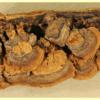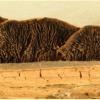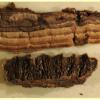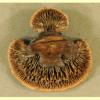
images/Gloeophyllum/Gloeophyllum_abietinum_MEL229852_TM_DSC_1025a.jpg
Tough, small to large agaric, growing on wood. Pileus brown, grey, rarely black, usually hairy, dry. Stipe absent. Partial veil remnants absent. Spores hyaline, non-amyloid, smooth; germ pore absent. Pleurocystidia present. Hyphal system trimitic with generative hyphae, skeletal hyphae and binding hyphae. Clamp connections present.
Lenzites and
Trametes elegans, which are also tough in texture, differ by producing a white rot, and have a pileus context that is pale and does not darken when KOH is applied. Compare also
Daedalea (not included in FunKey), which is known from Australia from a single collection of
Daedalea quercina from oak (
Quercus) in South Australia (Cunningham, 1965).
Daedalea has tough fruit-bodies with no stipe, produces a brown rot, and has a light brown pileus context that does not darken in KOH.
Gloeophyllum P.Karst., Bidrag Kännedom Finlands Natur Folk 37 [Ryssl. Hattsvamp. 1]: x, 79 (1882).
Three lamellate species: Gloeophyllum abietinum, G. sepiarium and G. striatum. The tropical Australian G. concentricum has a lamellate hymenium, but the lamellae are arranged concentrically, parallel to the edge of the pileus (Cunningham, 1965; Grey & Grey, 2005). The other species in Australia, Gloeophyllum trabeum, has a hymenium that is tubular-poroid to labyrinthiform, not lamellate.
W.A., N.T., S.A., Qld, N.S.W. and Vic. (and probably also Tas.).
In native forests and in plantations.
On wood, especially of conifers, such as native Callitris or exotic pine, but also on hardwoods.
Saprotrophic (brown rot).
Breitenbach, J. & Kränzlin, F. (eds) (1986),
Fungi of Switzerland.
Volume 2. Non gilled fungi. Heterobasidiomycetes, Aphyllophorales, Gasteromycetes. Verlag Mykologia, Lucerne. [
Illustration,
Description and
Microcharacters of
G. abietinum and
G. sepiarium]
Cunningham, G.H. (1965), Polyporaceae of New Zealand, Bull. New Zealand Dept. Sci. Industr. Res. 164: 1–304. [Description, B&W Illustration and Microcharacters of G. abietinum (with Lenzites bifasciatus as a synonym, which, however, is included under G. striatum by other authors, and with G. striatum as a synonym of G. trabeum]
Fuhrer, B. (2005), A Field Guide to Australian Fungi. Bloomings Books, Hawthorn. [Description and Illustration of G. abietinum and G. sepiarium]
Gilbertson, R.L. & Ryvarden, L. (1986), North American Polypores. Volume 1. Fungiflora, Oslo. [Description and Microcharacters of G. abietinum, G. sepiarium and G. striatum]
Hood, I.A. (2003), An Introduction to Fungi on Wood in Queensland. University of New England, School of Environmental Sciences and Natural Resources Management, Armidale. [Description and B&W Illustration of G. abietinum]
McCann, I.R. (2003), Australian Fungi Illustrated. Macdown Productions, Vermont. [Illustration of G. sepiarium and an unnamed species]
Quanten, E. (1997), The Polypores (Polyporaceae s.l.) of Papua New Guinea. National Botanic Garden of Belgium, Meise. [Description and Microcharacters of G. abietinum]
Ryvarden, L. & Johansen, I. (1980), A Preliminary Polypore Flora of East Africa. Fungiflora, Oslo. [Description and Microcharacters of G. striatum]






